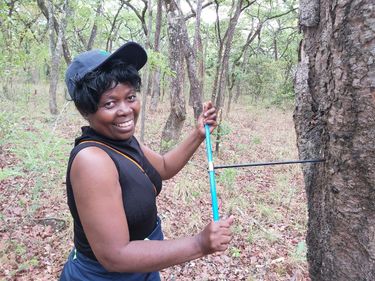
Paul Szejner
As a forest ecologist, I use stable isotopes in tree rings to study the relationships between plant physiology and environmental changes. I am interested in the mechanisms driving carbon and water fluxes on forested regions from seasonal to centennial scales.
Sessions in which Paul Szejner participates
Monday 27 June, 2022
Free, in person and onlineThe stable isotopic compositions of carbon and oxygen (d13C and d18O) measured in tree rings are valuable proxies for reconstructing paleoclimate and are increasingly used as paleophysiological proxies. Applying these proxies in ecophysiology and paleoclimate can be challenging as they rely on complex process-based models and poorly constrained input data. In recent years, h...
Tuesday 28 June, 2022
The ongoing North American megadrought has persisted since the year 2000, and has been characterized by anomalously low amounts of winter and summer precipitation. The climate systems providing these seasonal precipitation regimes are distinct in their origins but overlapping in their geographic ranges. However, our understanding is still incomplete in how alternation in water resources influences forest growth and physiology during extreme and persistent drought, including whether replete...
Wednesday 29 June, 2022
Session reescheduled from June 28th to June 29th
The ongoing North American megadrought has persisted since the year 2000, and has been characterized by anomalously low amounts of winter and summer precipitation. The climate systems providing these seasonal precipitation regimes are distinct in their origins but overlapping in their geographic ranges. However, our understanding is still incomplete in how alternation in water resources influences forest growth and physiology during extreme and persistent drought, including whether replete...
Thursday 30 June, 2022
The interpretation of stable isotopes in a dendroecological framework can provide powerful insights into how trees adjust physiologically in response to the environment. This symposium aims to bring together researchers who use stable isotopes in tree rings to address ecophysiological responses to environmental changes from intra-annual to multi-decadal resolution. We hope this symposium will enable fruitful discussions and new ideas a...
Sessions in which Paul Szejner attends
Monday 27 June, 2022
MAIDENiso is a numerical process-based model that allows researchers to simulate the growth of a virtual tree. Using daily meteorological data, the model simulates the physical and physiological processes taking place in the tree and its environment, to produce daily and yearly outputs comparable to dendrological observations. The model has been adapted and used successfully in boreal regions in North America. In an inverse mode, tree-ring obs...
Free, in person and onlineWe will hold a practical, skills-based workshop introducing openDendro -- an open-source framework of the base analytic software tools used in dendrochronology in both the R and Python programming languages. openDendro is a new unified set of tree-ring analysis tools in open-source environments that provides the necessary baseline for dendro...
Tuesday 28 June, 2022
Africa is faced with a number of challenges including climate change and ecological disturbance due to various anthropogenic activities. These problems adversely affect the forests and also ecosystem services. My appreciation for the forests motivated me to pursure my undergraduate studies in Forestry. I first applied dendrochronology during my PhD research which focused on understanding the climate change vulnerability of the Zambezi teak forests in Zambia. However, lack of research facil...
Climate change poses an existential threat to trees, given our understanding of the importance of climate in shaping their geographic distributions. Climate envelope models are commonly used to predict how species will respond to climate change. These models give rise to the leading edge-trailing edge paradigm for range change: populations at the cool edge of a species’ distribution are expected to benefit from warming, whereas populations at the warm edge are expected to decline. We chall...
Tree-ring time series provide long-term, annually resolved information on the growth of individual trees. However, public tree-ring archives contain a considerable portion of data collected from trees that have been selected with specific research questions in mind (e.g., for climate reconstruction). This makes these archives a biased representation of the sensitivity of forest ecosystems to ongoing climate variation (e.g. temperature, precipitation), including non-stationarity (i.e....
During the 21st century, the boreal biome has warmed at rates 3-4 times the global average, impacting forests directly through changes in temperature and precipitation and indirectly through acceleration of disturbances including permafrost thaw and wildfire. Despite this, little is known about the ability of boreal trees to adapt in the face of such rapid environmental changes. Warming-induced growth rate increases are predicted for the boreal biome, but these would be largely dependent o...
Forest disturbances and tree growth are major drivers of dynamics and long-term carbon storage in forests. Combining forest inventory data and tree-ring analysis allows for a retrospective estimate of aboveground forest biomass (AGB) and disturbance dynamics at decadal to centennial scales, both being directly related to net primary productivity (NPP). We used this combined approach to estimate precisely-dated ages of aboveground carbon in over 20 temperate old-growth forests in Western Eu...
Evidence of volcanic cooling and its human impacts has been described for various regions of the globe over the past several centuries to millennia, derived from paleoclimatic and historical data. Due to its remote location, detailed accounts of such impacts over Northwestern North America (NWNA) are still quite limited. Here we use a newly expanded tree-ring density network (derived from blue intensity as well as maximum latewood density parameters) to assess the climatic and human impact...
Mexico has a forest cover of 660,400 km2, representing 34% of its territory. Due to deforestation and land-use change, Mexico has lost 32,200 km2 over the last 25 years, representing 1.9% of its territory. Mexican forests are now additionally threatened by climate change. Currently, there is no assessment of the impact of current and future climatic changes on forest productivity to develop mitigation and adaptation plans in the forestry sector. Most growth studies in Mexico focus on clima...
The past and future of forests are unequivocally controlled and determined by global climate. Constraining the uncertainties within this multifaceted relationship has been the focus of vast research efforts. A spatial perspective, however, is often neglected. Using the geographical constraints (e.g. latitude, altitude) and climatic drivers of tree dynamics as a benchmark, we address the spatial patterns and changes of forest growth at a continental scale and quantify the forest growth resp...
Tree-ring time series provide long-term, annually resolved information on the growth of individual trees. However, public tree-ring archives contain a considerable portion of data collected from trees that have been selected with specific research questions in mind (e.g., for climate reconstruction). This makes these archives a biased representation of the sensitivity of forest ecosystems to ongoing climate variation (e.g. temperature, precipitation), including non-stationarity (i.e....
Ultra high resolution imaging is becoming standard across the sciences and must be a priority for dendrochronology. Large format scanners fail to resolve micro rings and the anatomical structures of increasing scientific interest. Meanwhile, current software limitations include cost, user experience, data management flexibility, and capacity for handling large file sizes. We argue for a new paradigm and present a technology framework that integrates gigapixel macro photography, a cloud-hos...
Few spring paleoclimate records are available for boreal Canada and given the warming of spring temperatures in recent decades and its impact on snowmelt and hydrological processes, the search for spring climate proxies is receiving increasing attention. Tree-ring anatomical features and intra-annual widths were used to reconstruct regional mean March-April-May temperature from 1770 to 2016 in eastern boreal Canada. Nested principal component regressions calibrated on 116 years of gridded ...
Tree-ring research has given generations of scientists a long memory of what is acceptable for a tree to be included for data analysis. The established criteria, however, were set through purposeful goals to maximize the response for climatic reconstructions. Ecology is different. Tree-rings are increasingly being used to study a wide swath of ecology, including the carbon cycle or the response of ecosystems to global changes. A fundamental aspect of ecology is to understand the range of r...
The objective of this study is to identify and estimate the impact of the change in climate on the annual growths of the three main forest species from Romanian forests: Norway spruce, European beech, and sessile oak. We have used more than 6500 increment cores of the National Forest Inventory in combination with the Romanian homogenized climatic data. To ensure more than 30 observations per time step, we have used quinquennials rather than years. Using a longitudinal autoregressive mixed ...
Climate extremes are driven by a combination of thermodynamical and dynamical factors. In Europe, the primary dynamical driver of summer climate extremes is the position of the jet stream over the Europe-North Atlantic (EU) region. To study long-term variability in the position of the EU jet, as well as its potential impact on past climate extremes and human systems, we have reconstructed EU jet variability over the past 800+ years (1200-2005 CE). To accomplish this, we have combined five ...
In this work we show the application of dendrochronology as an educational resource for schoolchildren and as a mean to disseminate science to society. Tree rings are popularly known in Chile due to the massive use of wood for construction, handicrafts and firewood. The visible tree rings generate a distinct, tangible and familiar curiosity in many people. “Tree-Rings as a Natural Encyclopedia of Environmental Archives” is an exhibition built as an educational project for schoolchildren, w...
As of 2020, 56% of the world’s population live in urban areas. These individuals benefit from numerous ecosystem services provided by urban forests, including urban heat island mitigation, energy use reduction, stormwater interception, wildlife and pollinator habitat provision, air pollution removal, and carbon sequestration. Urban greenspaces are also often the most accessible avenue for exposure to the natural environment, providing additional aesthetic, recreati...
Intra-annual tree-ring δ13C record has the potential to provide deep insights into past plant performance and environmental conditions. With concomitant high temporal resolution δ13C analysis of non-structural carbohydrates, the processes behind observed low- and high-frequency δ13C changes in tree-ring record could be interpreted more reliably. This is essential for predicting forest response to impacts of climate change, such as more frequent and severe drought episodes.To better ...
Improving our understanding of the carbon cycle is key to addressing the challenges of climate change. In this study, we investigated the relationships between intra and inter-annual climate variations, carbon fluxes, and the xylem biomass in an 80-year plantation of Pinus strobus at Turkey Point, Ontario, Canada. From eddy covariance tower, we obtained daily Gross Primary Production (GPP), precipitation and air temperature for the period 2003-2018. To determine inter-and intra-annual xyle...
Urban trees provide multiple benefits such as shading and cooling, which become more and more important due to the increasing frequency and severity of heat and drought periods. It is thus necessary to identify tree species, which are able to tolerate such extreme conditions in urban areas. We studied the resistance and resilience of stem diameter growth of five deciduous tree species in an urban area in Southwest Germany to three exceptional drought periods for differences between and wit...
In the context of climate and environmental change, the boreal forest is subject to potential changes in structure and function. Stand-level physiological models can be used to predict these responses over time and to understand the interaction between tree ecophysiological processes and climate variability. We present here a project that aims to develop potential growth scenarios for Canadian boreal forest stands based on the characterization of their ecosystem fluxes using the MAIDEN mod...
The Pliocene is often identified as an example of a past warmer world. Studies of sub-fossil wood from fossil forest localities in the Canadian Arctic have allowed us to explore the amplified effects of global climate change in the Arctic during the Pliocene and to provide important information on how arctic ecosystems respond to these changes. Here we report new annually resolved climate records developed from Meighen and Prince Patrick Islands, which span a time period from 6.2 Ma to 2.7...
Ring-width (RW) and Blue Intensity (BI) parameters (earlywood - EWB, inverted latewood – LWBinv, and delta - DB) were measured from samples of Araucaria araucana from six sites in northern Patagonia, Argentina. The distance between the most southerly and northerly sites is ca. 130 kms. Despite a much weaker between-tree signal for the BI parameters than RW, principal component analysis identifies a much stronger regional between-site signal for the BI parameters. Split period correlation r...
Chemical traits of tree-rings are sparsely used for dendroclimatic analysis. The difficulty of the laboratory process to obtain these proxies and understand their physiological relationship with meteorological variables have limited the development of dendrochemistry in tropical forests. Here, we show the first Micro X-ray fluorescence (µXRF) time series of chemical elements from Cedrela fissilis trees growing in southern Brazilian Amazon. We assess the relationships among wood traits (wid...
The impacts of inland flooding caused by tropical cyclones (TCs), including loss of life, infrastructure disruption, and alteration of natural landscapes, have increased over recent decades. While these impacts are well documented, changes in TC precipitation extremes—the proximate cause of such inland flooding—have been more difficult to detect. Here, we present a latewood tree-ring–based record of seasonal (June 1 through October 15) TC precipitation sums (ΣTCP) from the region in North ...
Global warming in boreal forests is more pronounced than elsewhere, as temperature is increasing twice as fast as the rest of the planet. Low water availability in some boreal forest stands is one of the numerous consequences of increasing temperature. Sites with coarse surficial deposits where water drains fast are more vulnerable to water stress, such as sites on esker fluvioglacial deposits. The eskers of the Abitibi region of Quebec (Canada) are valuable ecosystem for wood provision an...
The representation of snow processes in forest growth models is necessary to accurately predict the hydrological cycle in boreal ecosystems and the isotopic signature of soil water extracted by trees, photosynthates and tree-ring cellulose. Yet, most process-based models do not include a snow module, consequently their simulations may be biased in cold environments. Here, we modified the MAIDENiso model to incorporate a new snow module that simulates snow accumulation, melting and sublimat...
Dendroprovenance is a discipline usually linked to dendroacheology or wood commercialization; however, other purposes as inferring the origin of wood in rivers (i.e., instream large wood, LW) are often overlooked. LW in fluvial ecosystems enhances its geomorphology and biodiversity, but also increases potential risk during floods. Thus, knowledge about its source is crucial for understanding LW dynamics and optimizing river and riparian forest management. This project aims at deve...
The current climate warming is unique in terms of its ubiquity and synchrony on a global scale. Over the last millennium, pre-industrial periods with warmer and colder temperatures occurred at different times in different locations around the globe (Neukom et al., 2019). Long-term temperature reconstructions in the Southern Hemisphere remain sparse and not always consistent among them (Lara et al., 2020). Therefore, to understand the temporal and spatial patterns of global-scale temperatur...
Drought, flooding, and hurricane activity disrupt the human and natural landscape throughout the southeastern United States. Instrumental records through the past century suggest that the patterns of these extreme events are changing through time, especially in relation to rising global temperatures. However, instrumental records before the industrial revolution are rare, thus proxy records like tree rings are useful for comparing climatological conditions before massive human modification...
We report on research to develop quantitative, annually resolved, multi-century, tree-ring reconstructions of streamflow for 12 interstate river systems in eight states (Alabama, Florida, Georgia, Louisiana, Mississippi, North Carolina, South Carolina, and Virginia) in the South Atlantic Gulf Basin (AGB) of the southeastern United States.We used a nested principal components regression method to develop annually resolved tree-ring reconstructions of warm-season (March-October streamflo...
Circulation models forecast changes in global temperature and precipitation that will likely alter forest function. North America is expected to experience increases in intensity and frequency of hot days and nights, and is already experiencing severe and frequent drought and forest fires. Current forest dieback has been attributed to climate change, however forest resilience to climate variability is not well understood. Tree ring records can be used to assess this resilience. In particul...
Wednesday 29 June, 2022
Dendrochronology is considered one the most precise of all the scientific dating techniques. However, it requires long sequences of tree rings and a master record for both the species and region in question. At the University of Groningen, we have been pioneering a new approach to dating that combines the precision of dendrochronology with the versatility of radiocarbon dating. It relies on the detection of spikes in the annual radiocarbon record, thought to b...
Current and projected changes in climate are estimated to be from 10 to 100 times faster than the natural adaptive capacity of trees whose generation times are long. As extreme climatic events are becoming more frequent and exert a strong selection pressure on tree populations, there is an urgent need to better characterize the genetic variability involved in the response of trees to climate. There is currently a lack of knowledge on the role of genetic variability in tolerance to climatic...
In the 1970s, forest geneticists with the British Columbia Forest Service established a number of long-term provenance trials throughout the province. The Trinity Valley (TV) provenance trial was established in 1975 in the southern interior to evaluate interior Douglas-fir (Pseudotsuga menziesii var. glauca) across the species’ range. TV is a factorial experiment, where 64 populations of 4 year-old Douglas-fir seedlings were planted in a randomized complete-block design with three replicat...
Climate change threatens forest trees. Their ability to resist depends on their potential to adapt. Phenotypic plasticity, i.e. the potential for individual adaptation, is a rapid mechanism that can allow trees to adjust to new climatic conditions. Tree-rings allow retrospective estimation of phenotypic plasticity of wood formation to climate in forest trees. In this study we show how to estimate linear reaction norms of annual ring variables as a function of climate. We use the slope of t...
Rapidly warming climate affects water availability for boreal conifer species, thus urging the need for assessing their adaptive capacity to better predict forest vulnerability and resilience under drier climates. In this study, we first used a dendroecological approach to determine the level of climate sensitivity of white spruce (Picea glauca [Moench] Voss) trees grown in a provenance-family common garden. We detected a clear signal of local genetic adaptation to drought, with provenance...
Assisted gene flow (AGF) may help facilitate tree species’ adaptation to future climatic conditions. When applied to resource-producing species such as black spruce (BS, Picea mariana), AGF could contribute to maintaining forest productivity and therefore carbon sequestration. For AGF to succeed, it is important to determine how growth varies among different populations under different climates, especially for species with large distribution ranges. Existing common garden experiments repre...
Forty years ago Dr. Tom Yanosky, a research botanist with the US Geological Survey, reported that ash trees growing along the Potomac River contained rings with abnormal wood anatomy caused by flood damage. Dr. Yanosky recommended these rings — which he dubbed “flood rings” — could be used to estimate the date, seasonal timing, and (most importantly) peak stage of past floods. Since that discovery, flood rings have been identified for forested river systems in eastern France, central Canad...
Coastal maritime forests in northeastern USA are mostly fragmented and currently threatened by climate change. This study focuses on American holly (Ilex opaca) trees located in the coastal maritime forests of Sandy Hook, N.J. and Fire Island, N.Y. to better understand how vulnerable and resilient these forests are to future climate scenarios. There are few published studies that use tree-ring methods in the maritime forests of N.J. and dendrochronological research on holly species has jus...
In western Canada, internal natural variability is the dominant source of uncertainty for the climate model projection of precipitation and related variables. Tree-ring records capture this natural variability and also enable testing of the capacity of climate models to simulate significant modes of variability. We compare millennial tree-ring reconstructions of the weekly flows of the Athabasca and North Saskatchewan Rivers to weekly flows from a hydrological model forced with climatology...
"Drought legacy effects (DLE) in radial tree growth (RTG) have been extensively studied over the last decade and are found to critically influence carbon sequestration in woody biomass. However, the statistical significance of DLE depends on our definition of expected vs. unexpected growth variability, a definition that has not received sufficient scrutiny.Here, we revisit popular DLE analyses using the ITRDB and employ a synthetic data simulation to disentangle four key factors influe...
Presentation of all Ameridendro2022 posters.FREE LUNCH FOR ALL ATTENDEES!
The use of stable isotope proxies in combination with tree-ring parameters has become a well-established tool to unravel plants’ responses to a changing environment. However, while there have been many studies on intra-annual wood formation processes, the specific details of the fractionation of stable isotopes in high-resolution time scales -knowing the exact date of fractionation- remain unknown. Such a time scale mismatch, provides obstacles to investigate the timing, sensitivity and in...
Forest carbon (C) balance projections rely on models describing tree physiological processes to assess forest growth. The representation of C allocation and xylogenesis is still a source of uncertainty in these projections. The objective of this project is to improve boreal C balance projections by including explicitly tree C allocation and wood formation processes in modeling.We will use xylogenesis monitoring data from micro-cores and dendrometers over two gradients. A longitudinal g...
Stable carbon (δ13Cc) and oxygen (δ18Oc) isotopes in tree-ring cellulose, and tree-ring width (TRW), have been used extensively to investigate the effects of climate on tree growth. By contrast, the information recorded by the non-exchangeable carbon-bound hydrogen (δ2Hc) isotopes, has been far less explored. To create a comprehensive assessment of δ2H potential as a proxy for climate, hydrology, plant metabolism, and physiology we explored its relationships with climate an...
Soil moisture (SM) is a crucial variable to the energy balance between the soil and the atmosphere. Given the lack of long-term instrumental SM measurements, information captured by satellites and climate reanalysis emerges as a useful tool. In the Mediterranean ecosystems of Chile (MC; 30°-36°S), several studies have reported a forest decline mainly associated with a persistent mega-drought (MD) during the last decade. We evaluated the main spatio-temporal patterns of tree growth during 1...
"Multi-centennial to millennial-long oak ring width chronologies from living and relict wood are frequently used for climate reconstructions, but the amount of explained hydroclimatic variation remains relatively small. Although stable carbon and oxygen isotopic ratios (δ13C and δ18O values) in tree rings may offer enhanced climate sensitivity, our understanding of their paleoclimatic sensitivity is still limited by the general lack of well-replicated and high-resolution datasets. Here, we...
The main objective of this project is to quantify the increased productivity of Betula glandulosa Michx in Umiujaq, Nunavik, northern Quebec and evaluate how climatic and edaphic conditions influence this change. The speed at which climate change is affecting the northern ecosystems remains poorly understood and data are needed to anticipate future ecological and physiological trajectories of the vegetation. We produced a tree-ring chronology from approximately 40 specimens of Betula gland...
Oxygen isotope ratios in tree rings (δ18OTR) from Amazon forests have been shown to provide historical records of rainfall amounts at a large scale, due to the rainout of heavy isotopes during moisture transport. Here, we present a 110-year oxygen isotope record obtained from tree ring-cellulose of six Cedrela odorata trees (rbar = 0.57, EPS = 0.89) from the region of Tapajos River, Eastern Amazon. Our analysis indicates that δ18OTR series reflects inter-annual variability of wet season (J...
Water scarcity is a major 21st century challenge that is increasing the vulnerability of the human population, especially in cities. Water risk assessment is a fundamental task in many cities worldwide that often lack long-term and spatially-resolved records of precipitation and level of water reservoirs. Past rainfall and reservoirs levels may be alternatively assessed using tree-ring stable isotopes of urban trees. We assessed the past variability of precipitation and reservoirs level th...
Hydroclimate variability in tropical South America is strongly regulated by the South American Summer Monsoon (SASM). However, past precipitation changes are poorly constrained due to limited observations and high-resolution paleoproxies. We found that summer precipitation and the El Niño-Southern Oscillation tarapacana (ENSO) in the Chilean variability and Bolivian are well registered Altiplano in in tree-ring the Central stable Andes oxygen (18–22°S, isotopes ∼4,500 (δ18OTR) m a.s.l.) of...
Despite their potential benefits, streamflow reconstructions from tree-rings have not been widely used in water systems analysis because the flow is generally constructed at annual resolution, which may be too coarse for analysis of drought/flood vulnerability and decision making. In semi-arid regions of Chile there are very good relationships between these daily and annual flow, which is explained because within these regions, few hydrological events within a year explain most of the annu...
This is a mandatory (!) .... and FREE (!!) cocktail & award ceremony (!!!)(in replacement of the Banquet formula)->->->->->->->->->->->->->->->->->->After a great summer day of scientific and urban discoveries in our beloved MTL, we wish to bring together all the AmeriDendro community in one place and congratulate the TRS awardees for their remarkable achievements! -Bonsinsegna award-Fr...
Thursday 30 June, 2022
How old are tropical trees? This fundamental question has long driven the curiosity of laymen and scientists. But only recently, a great number of studies conducted by many brave dendrochronologists resulted in a significant tree-ring-based knowledge that allows us to start accurately estimating tree ages across the globe. As science goes, not only knowing the longevity of tropical trees is essential to understanding forest dynamics and its role in biogeochemical cycles, but one must also ...
Dendrochronological archives in the tropics of the Americas have been under-studied for a long time. Some of the challenges include the Identification of tree-ring boundaries in certain tree species, absence of winter dormancy associated to low temperatures in most of the cases, and logistic difficulties of fieldwork in remote sites. However, part of the slow progress is also related to the fact that historically much less resources have been inv...
Methodological advances in the latest years have opened new perspectives for dendrochonological studies by facilitating the visualization, delimitation, and analyses of tree-rings. These novel methodologies have incorporated complementary physical and chemical parameters to the traditional anatomical procedures used to describe annual growth rings. Here, we present the results of new studies which explore the relationships among wood density features and chemical elements involved in the a...
Exploring new study sites and potential species is still a fundamental step in tropical dendrochronology. The results of exploratory field campaigns usually reflect the intrinsic biodiversity of the tropics: a plethora of wood anatomy variation and seemly true tree-ring boundaries. Often, some species are excluded during the process of selecting the best species due to indistinct or rather unclear tree-ring delimitation, aside from the difficult task to discriminate the commonly found fals...
Tropical regions are generally characterized by dynamic ecosystems where the abundant availability of energy and resources allows for an almost constant growth of its flora, being xeric forests and flood plains some exceptions. Classical dendrochronology studies have been scarce in these areas as many tree species does not show well defined tree-ring boundaries. We present different study cases on how quantitative wood analysis and radiocarbon can complement classical dendrochronology incr...
In tropical environments of central America, tree-ring forming species are rare to find, especially in areas with pronounced aseasonality, but wood anatomical traits can equally provide important information on species life-histories and response to disturbances. Dating wood anatomical structures remains a crucial task to decipher the ecological information recorded in xylem cellular parameters in absence of defined ring boundaries, particularly to observe the footprint of discrete disturb...
The state of fragmented populations of tree Polylepis genus heavily impact by human activities leads to the need to conduct ecological studies to better understand their vulnerability. We evaluated the newly identified tree species Polylepis rodolfo-vasquezii, endemic to central Peruvian Andes, distributed from 3700 to 4750 m a.s.l. and suitable for dendrochronological studies. Our objectives were twofold: (1) to determinate age population in both forests and developed linear models that c...
In the tropical Andes several species of the genus Polylepis have been reported to be useful to record climate variability using tree-ring width, expanding the geographical distribution of proxy records into the tropical region. However, in the tropics classical dendrochronology based on ring-width patterns is often challenging, hampering the development of climate reconstructions. Alternative methods can confirm annual periodicity of tree rings, and help on extracting more reliable climat...
Given the short span of instrumental hydroclimatic records in the South American Altiplano, longer time records are needed to understand the nature of climate variability and to improve the predictability of precipitation, a key factor modulating the socio-economic development in the Altiplano and adjacent arid lowlands. In this region growths P. tarapacana, a long-lived tree species being very sensitive to hydroclimatic changes and widely used for tree-ring studies in central and southern...
Polylepis tarapacana is the longest paleoclimatic tree-ring archive in the South American southern tropics. It grows up to 5200 m a.s.l. in the South American Altiplano, a semiarid-high elevation Andean Plateau. P. tarapacana ring-widths (RW) have provided centuries of past hydroclimate information, but the potential use of tree-ring stable isotopes for paleoclimatic or ecophysiological studies remained understudied for this species. Here, we developed a network of four RW, oxygen (δ18O) a...
Dendrochronological archives in the tropics of the Americas have been under-studied for a long time. Some of the challenges include the Identification of tree-ring boundaries in certain tree species, absence of winter dormancy associated to low temperatures in most of the cases, and logistic difficulties of fieldwork in remote sites. However, part of the slow progress is also related to the fact that historically much less resources have been inv...
The occurrence of annual growth rings in tropical trees—the result of the seasonal activity of vascular cambium—has been explained either by seasonal periods of water deficit or flooding. However, little is known about the drivers of annual tree-ring formation under tropical hyper-humid conditions without evident seasonal dry periods or flooding (ever-wet conditions). Shelford's law states that both the deficit and the excess of environmental resources limit plant growth. Accordingly, we h...
The most biodiverse region in the world can be found in the tropical Andes (~5º-24ºS) between Venezuela and the Bolivian Altiplano, yet it is highly under-sampled in dendrochronology in part due to the prevalence of trees without rings (continuous growth) and the overall hyperdiversity of the ecosystems. The Madidi National Park (MNP) in northern Bolivia. (~14 ºS, -68°W) is a biodiversity hotspot with lowland rainforests and high montane environments that provide unique opportunities for t...
The Caribbean, like much of the tropics, is underrepresented by tree-ring chronologies making global climate reconstructions a challenge because of these blind spots. We have developed a multi-centennial tree-ring chronology from 120 samples of Pinus occidentalis trees located above 2800 m elevation on the dry slopes of Loma la Pelona in the Cordillera Central (19.035278 N, -71.005278 W) of the Dominican Republic. We used skeleton plotting on multiple radii from each crossection to date th...
In this presentation we discuss the current status of tree-ring research in the neotropical Americas outside of México. The most relevant findings are discussed, including the region-wide wet season precipitation signal associated with large-scale tropical atmospheric dynamics. Our analysis suggests that local climate response patterns vary between sites, with the strongest correlations ranging from the previous summer to the current spring. Correlations with accumulation of daily precipit...
A gap of millennial tree-ring data suitable for dendroclimatology has long been evident in the North American boreal forest. In my talk, I will describe the adaptive approach we have developed to build and improve a data network for millennial dendroclimatology in the eastern Canadian taiga. Recurrence of stand replacing wildfires is the most important constrain to the elaboration of long tree ring chronologies, which can only be developed away from regions ...
Climate change across the western US has increased air temperature, resulting in decreased snow and lengthening of the summer drought. Recent studies have also highlighted the positive feedback loops between soil moisture and vapor pressure deficit (VPD), which can exacerbates aridity in water limited ecosystems. These interactions can make it difficult to untangle the influences of soil moisture and VPD on tree growth, and yet our ability to untangle these parameters is important for buil...
In the southwestern U.S. the North American Monsoon (NAM) delivers summer precipitation from July – September and the rest is provided as snowmelt in early spring. Both periods serve as an important water source for plants, but due to the heterogeneous nature of the NAM, not all locations within the region receive precipitation, leading to differences in soil moisture. Understanding how spatially heterogeneous soil water storage controls plant water use is needed, especially with projected...
Hydrogen isotope ratios in tree ring cellulose (δ2HC) have been recognized as a potential proxy for plant-climate interactions, plant physiology, and carbon metabolism. This goes along with recent studies showing species-specific δ2HC differences that cannot be explained by climatic conditions. However, systematic investigations on the phylogenetic impact on 2H-fractionations in carbohydrates of woody plant species are missing.Here, we sampled leaves and twigs of 152 trees and ...
The ability of forests to continue absorbing atmospheric CO2, and hence mitigating climate change, depends on the extent to which their productivity is limited by nutrients, with nitrogen (N) being particularly important in temperate and boreal regions. Fertilisation experiments offer an opportunity to directly determine whether atmospheric N input can contribute to alleviating N limitation. However, the majority of the experiments have normally considered soil N applications, which do not...
Under elevated CO2, photosynthetic carbon isotope discrimination is expected to increase in response to photosynthesis stimulation. While this response is widely documented in laboratory and field experiments, long-term proxies indicate that such response is not universally observed in response to the growth of atmospheric CO2. We investigated historical trends of photosynthetic carbon isotope discrimination derived from carbon isotope measurements of tree rings (Δ13C) from 147 chron...
Drought conditions have been projected to increase globally as atmospheric CO2 (ca) and vapor pressure deficit (VPD) increase. Experimental and modelling studies have suggested that forest responses to drought may be bolstered by increased ca, but it remains unclear how prevalent this response is in natural forest ecosystems. We developed a framework using intrinsic water use efficiency (WUEi = assimilation (A)/ stomatal conductance (gs)) and evaporative water use efficiency (WUEE = A/tran...
The boreal forest located in high northern latitudes stores about a third of the world’s carbon and covers almost a quarter of the Earth’s land surface. This region is experiencing one of the fastest temperatures increases on the planet. Yet it is unclear how global warming affects carbon sequestration and storage in this biome. Here, we explore how white spruce (Picea glauca [Moench] Voss) growing in North America responded to climate change during the 20th century using tree-ring width a...




